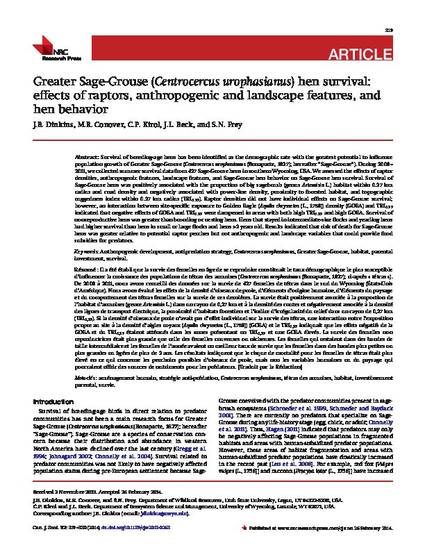
Article
Greater Sage-Grouse (Centrocercus urophasianus) hen survival: effects of raptors, anthropogenic and landscape features, and hen behavior
Canadian Journal of Zoology
(2014)
Abstract
Survival of breeding-age hens has been identified as the demographic rate with the greatest potential to influence population growth of Greater Sage-Grouse (Centrocercus urophasianus(Bonaparte, 1827); hereafter “Sage-Grouse”). During 2008–2011, we collected summer survival data from 427 Sage-Grouse hens in southern Wyoming, USA. We assessed the effects of raptor densities, anthropogenic features, landscape features, and Sage-Grouse hen behavior on Sage-Grouse hen survival. Survival of Sage-Grouse hens was positively associated with the proportion of big sagebrush (genus Artemisia L.) habitat within 0.27 km radius and road density and negatively associated with power-line density, proximity to forested habitat, and topographic ruggedness index within 0.27 km radius (TRI0.27). Raptor densities did not have individual effects on Sage-Grouse survival; however, an interaction between site-specific exposure to Golden Eagle (Aquila chrysaetos (L., 1758)) density (GOEA) and TRI0.27 indicated that negative effects of GOEA and TRI0.27 were dampened in areas with both high TRI0.27 and high GOEA. Survival of nonreproductive hens was greater than brooding or nesting hens. Hens that stayed in intermediate-size flocks and yearling hens had higher survival than hens in small or large flocks and hens >2 years old. Results indicated that risk of death for Sage-Grouse hens was greater relative to potential raptor perches but not anthropogenic and landscape variables that could provide food subsidies for predators.
Disciplines
Publication Date
2014
DOI
https://doi.org/10.1139/cjz-2013-0263
Citation Information
Michael Conover. "Greater Sage-Grouse (Centrocercus urophasianus) hen survival: effects of raptors, anthropogenic and landscape features, and hen behavior" Canadian Journal of Zoology Vol. 92 Iss. 4 (2014) p. 319 - 330 Available at: http://works.bepress.com/michael-conover/79/
